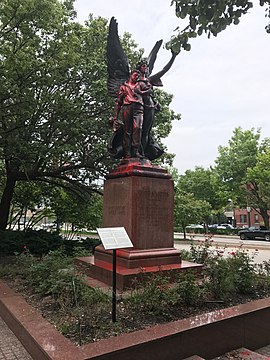Confederate Soldiers and Sailors Monument (Baltimore)
| Confederate Soldiers and Sailors Monument | |
|---|---|
 The monument covered with red paint in August 2017 | |
 | |
| Artist | Frederick Ruckstull |
| Year | 1902 2017: removed |
| Medium | Bronze sculpture |
| Location | Baltimore, Maryland, United States |
| 39°18′32″N 76°37′21″W / 39.308783°N 76.622455°W | |
| Owner | City of Baltimore |
The Confederate Soldiers and Sailors Monument was a monument in Baltimore, Maryland, installed in 1903 and removed in 2017.[1]
Description and history
The Maryland Daughters of the Confederacy raised money for the monument privately and commissioned a sculptor from New York City, F. Wellington Ruckstuhl to build it. The monument was dedicated on May 2, 1903.[2]

The statue shows Glory supporting a fallen soldier, his standard lowered but her wreath of History held high. The inscription at the base of the monument read, "GLORIA VICTIS", meaning "Glory to the Vanquished"[2] and To The Soldiers and Sailors of Maryland in the Service of The Confederate States of America, 1861–1865.[3] On the right side it read: "Deo vindice", on the left: "Fatti maschii, parole femine"[4] and on the rear Glory Stands Beside Our Grief. Erected by the Maryland Daughters of the Confederacy, February 1903.[5]

The monument was marked in June 2015, with "Black Lives Matter" scrawled across its side in the aftermath of the Charleston church shooting.[6] In August 2017, its statue was covered with red paint.[7] It was removed during the same month along with all other Confederate monuments in the city after the Baltimore City Council unanimously voted on August 14, 2017, to have it removed along with the Stonewall Jackson and Robert E. Lee Monument, the Roger B. Taney Sculpture, and the Confederate Women's Monument.[8][9][10]
See also
- List of Confederate monuments and memorials
- List of public art in Baltimore
- Removal of Confederate monuments and memorials
References
- ^ Prudente, Tim. "Confederate monument in Baltimore drenched with red paint". Baltimore Sun.
- ^ a b Kelly, Cindy (May 3, 2011). Outdoor Sculpture in Baltimore: A Historical Guide to Public Art in the Monumental City. JHU Press. p. 181. ISBN 9780801897221.
- ^ "List of removed Baltimore Confederate monuments". The Baltimore Sun. August 18, 2017. Retrieved December 28, 2017.
- ^ Soderberg, Susan Cooke (1995). Lest We Forget: A Guide to Civil War Monuments in Maryland. University of Wisconsin-Madison. p. 9. ISBN 9780942597769.
- ^ Billups, C. S. (2000). Lady Louise founder of the Maryland Division United Daughters of the Confederacy: a compilation of official records, newspaper articles and book references on the lives of Louise Wigfall Wright and Daniel Giraud Wright and their descendants as well as David Gregg McIntosh and Virginia Johnson Pegram and their descendants. University of Wisconsin-Madison. p. 46.
- ^ Rector, Kevin (June 22, 2017). "National conversation on Confederate symbology lands in Baltimore, scrawled in yellow paint". The Baltimore Sun. Retrieved December 27, 2017.
- ^ Prudente, Tim (August 14, 2017). "Confederate monument in Baltimore drenched with red paint". The Baltimore Sun. Archived from the original on August 16, 2017. Retrieved August 16, 2017.
- ^ Miller, Hayley (August 16, 2017). "Baltimore Quietly Removed All 4 of Its Confederate Statues Overnight". Huff Post.
- ^ Grierson, Jamie (August 16, 2017). "Baltimore takes down Confederate statues in middle of night". The Guardian.
- ^ Campbell, Colin; Broadwater, Luke (August 26, 2017). "Citing 'safety and security,' Pugh has Baltimore Confederate monuments taken down". The Baltimore Sun. Retrieved December 12, 2021.
External links
 Media related to Confederate Soldiers and Sailors Monument (Baltimore, Maryland) at Wikimedia Commons
Media related to Confederate Soldiers and Sailors Monument (Baltimore, Maryland) at Wikimedia Commons
